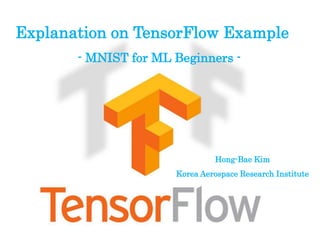
MNIST for ML beginners
- 1. Explanation on TensorFlow Example - MNIST for ML Beginners - Hong-Bae Kim Korea Aerospace Research Institute
- 2. x_image (28x28) Reshape 28x28 784x1 vector . . . 10 digits Networks Architecture . . W, bx y=softmax(Wx+b) Classifier Nets Very simple Classier Nets
- 3. MNIST For ML Beginners • Machine Learning 입문자를 위한 손글씨 숫자 분류기 만들기 • MNIST는 간단한 이미지의 집합으로 아래와 같은 손으로 적은 숫자로 구성 • 간단한 Classifier Nets를 구성하고 작동원리를 이해 • Softmax Regression으로 숫자를 추정
- 4. Define phase : Computation result is not determined Define data and model Construct learning model Define cost function and optimizer Run phase : can get a computation result in the case of putting model into session Execute computation Learning process using optimizer To execute the graph, Needs to connect with Core module Real computation is performed in Core module Computation process consists of two phases
- 5. • Tensorflow의 라이브러리를 불러옴. >>> import tensorflow as tf • MNIST 데이터 다운로드 >>> import input_data >>> mnist = input_data.read_data_sets('MNIST_data', one_hot=True) mnist.tran:training 데이터 55,000 mnist.test:test 데이터 10,000 mnist.validation:validation 데이터 5,000 >>> sess = tf.InteractiveSession() 데이터 불러오기 Define Phase
- 6. mnist.trans.xs, mnist.trans.ys 를 아래와 같이 정의 각이미지의 출력정답데이터 28pixel×28pixel의 이미지를 28×28=784의 벡터로 변환 벡터의 요소는 0(백)~1(흑)의 실수 각이미지의 입력벡터 데이터 1 0 0 0 0 0 0 0 0 0 “0”일 경우 0 0 0 0 0 1 0 0 0 0 “5”일 경우 Define Phase
- 7. 변수의 정의 • 입력 이미지데이터(28x28=784)의 텐서 사이즈를 정의 >>> x = tf.placeholder(tf.float32, [None, 784]) • Weight 사이즈를 정의하고 초기화 >>> W = tf.Variable(tf.zeros([784, 10])) • Bias의 사이즈를 정의하고 초기화 >>> b = tf.Variable(tf.zeros([10])) • 출력의 정의 >>> y = tf.nn.softmax(tf.matmul(x, W) + b) • 출력 정답데이터(10x1)의 텐서 사이즈를 정의 >>> y_ = tf.placeholder(tf.float32, [None, 10]) Define Phase
- 8. Softmax Regressions 입력데이터(x)가 Nets의 연산과정(Wx+b)을 거친 후 10개의 숫자 중 어느 것에 해당하는지에 대한 확률 계산 𝑝 𝑦(𝑖) = 0 𝑥(𝑖); 𝑤 ⋮ 𝑝 𝑦(𝑖) = 9 𝑥(𝑖); 𝑤 = 1 𝑗=1 10 e 𝑤j T 𝑥(𝑖) ew1 T 𝑥(𝑖) ⋮ ew10 T 𝑥(𝑖) y=softmax(Wx+b) 0.85 0.05 0.05 0.01 0.01 0.01 0.01 0.02 0.01 0.03 “0”일 경우 0.01 0.05 0.05 0.01 0.01 0.90 0.01 0.02 0.01 0.03 “5”일 경우 ∑=1 ∑=1 Define Phase
- 9. 손실함수(Loss Function)의 정의 >>> cross_entropy = -tf.reduce_sum(y_*tf.log(y)) For 𝑦_𝑖 = 1 𝑐𝑎𝑠𝑒 J(w)=log𝑦𝑖 𝑦𝑖 1 J(w) As 𝑦𝑖 approaches to 1, J(w) becomes 0 J(w)=-∑𝑦_𝑖•log𝑦𝑖 y : 분류기에서 추정한 확률값 y_ : 정답 Define Phase
- 10. >>> train_step = tf.train.GradientDescentOptimizer(0.01).minimize(cross_entropy) Backpropagation Algorithm의 정의 cross_entropy를 최소화하도록 GradientDescentOptimizer를 사용하여 훈련한다. Define Phase Learning rate
- 11. Run phase # 변수 초기화 >>> init = tf.initialize_all_variables() >>> sess = tf.Session() >>> sess.run(init) 훈련실시 >>> for i in range(1000): ... batch_xs, batch_ys = mnist.train.next_batch(100) ... sess.run(train_step, feed_dict={x: batch_xs, y_: batch_ys}) i<1000 ? 랜덤하게 100개의 이미지 데이터 를 선택하여 입력을 batch_xs, 출력정답을 batch_ys로 지정 훈련 실시 i=i+1 yes No end
- 12. Run phase 훈련된 분류기의 검증 • 정답의 정의 >>> correct_prediction = tf.equal(tf.argmax(y, 1), tf.argmax(y_, 1)) Returns the index with the largest value across dimensions of a tensor Return “1” if argmax(y, 1) = argmax(y_, 1), otherwise return “0” • 정확도의 정의 >>> accuracy = tf.reduce_mean(tf.cast(correct_prediction, 'float')) Casts a tensor to “float” calculate mean value • 정답율을 계산하여 표시 >>> print(accuracy.eval({x: mnist.test.images, y_: mnist.test.labels}))